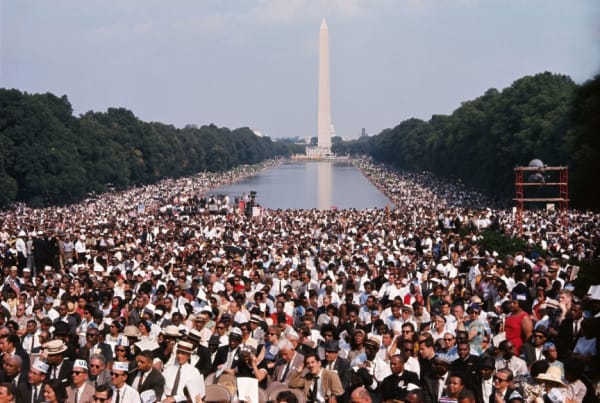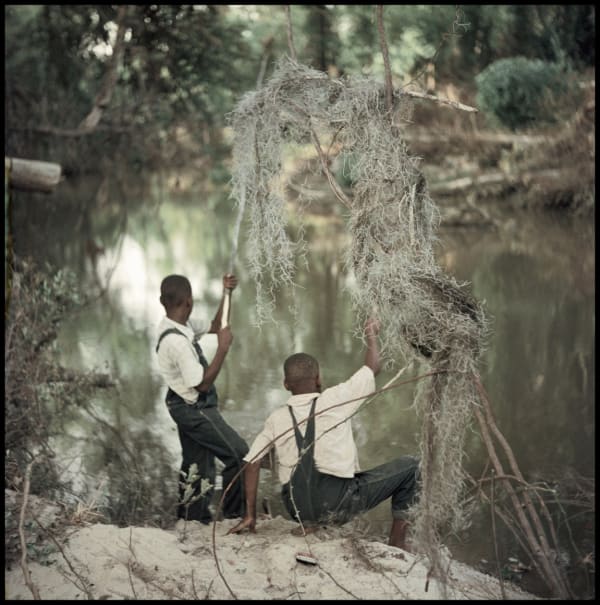Higher Ground: Gordon Parks
Jenkins Johnson Gallery, San Francisco is pleased to present Gordon Parks: Higher Ground, a solo exhibition of over sixty works by one of the most important photographers of the 20th century. The gallery’s second solo exhibition for Parks, on view from February 4 through April 2, 2016, will commemorate his photo essays on the Civil Rights Movement.
Gordon Parks (1912 - 2006) was the first black photographer to work at Life magazine. The show will include hallmarks from this period including the essays Invisible Man, 1952; Segregation Story, 1956; Duke Ellington, 1960 The March on Washington, 1963; The Nation of Islam, 1963; Muhammad Ali, 1970; and The Black Panthers, 1970. Parks’ empathy and charisma enabled him to gain access into his subject’s world matched by few photographers. Higher Ground focuses on a period of strife and turmoil in American history. The show coincides with the 150th anniversary of the end of the Civil War, as well as the recent milestones of the Civil Rights Act, 1964, and the Voting Rights Act, 1965.
Jenkins Johnson Gallery, San Francisco is pleased to present Gordon Parks: Higher Ground, a solo exhibition of over sixty works by one of the most important photographers of the 20th century. The gallery’s second solo exhibition for Parks, on view from February 4 through April 2, 2016, will commemorate his photo essays on the Civil Rights Movement.
Gordon Parks (1912 - 2006) was the first black photographer to work at Life magazine. The show will include hallmarks from this period including the essays Invisible Man, 1952; Segregation Story, 1956; Duke Ellington, 1960 The March on Washington, 1963; The Nation of Islam, 1963; Muhammad Ali, 1970; and The Black Panthers, 1970. Parks’ empathy and charisma enabled him to gain access into his subject’s world matched by few photographers. Higher Ground focuses on a period of strife and turmoil in American history. The show coincides with the 150th anniversary of the end of the Civil War, as well as the recent milestones of the Civil Rights Act, 1964, and the Voting Rights Act, 1965.
The Invisible Man story is based on Ralph Ellison’s 1952 National Book Award winning novel that captures the essence of social isolation and the struggle of a black man who feels invisible to the outside world. Parks’ work, Invisible Man Retreat, Harlem, New York, 1952, juxtaposes the scene of the man in his small section of basement surrounded by a halo of 1,369 lights that illuminate him as he listens to records while hidden below the dark city skyline. “My hole is warm and full of light. Yes, full of light. I doubt if there is a brighter spot in all New York than this hole of mine, and I do not exclude Broadway.” An in-depth presentation of this work, Invisible Man: Gordon Parks and Ralph Ellison in Harlem, will open in May of this year at the Art Institute of Chicago.
2015 marked the sixtieth observance of what many call the beginning of the Civil Rights Movement. On December 1, 1955 Rosa Parks pressed on the upward way by refusing to give up her bus seat to a white passenger in Montgomery, Alabama, which led to the organized bus boycotts. Soon after, Life sent Gordon Parks on assignment to Mobile, Alabama to document the effect of Jim Crow laws mandating racial segregation. Parks’ story The Restraints: Open and Hidden focused on the daily lives of Mr. and Mrs. Albert Thornton, their nine children, and nineteen grandchildren. Parks photographed the family and their daily life from Alabama to Tennessee, highlighting racism and segregation. After the Life story was published the family received death threats causing one family to abandon their home. Untitled, Alabama, 1956 tenderly depicts two young girls playing with teacups in murky water in front of a typical southern shanty shack. The images that Gordon captured in the series Segregation Story reveal the realities of the Jim Crow south. In the churches, homes, fields, and streets of the segregated south one would often hear the old spiritual hymn:
Pressing on the upward way • New heights I am gaining every day;
Still praying as I onward bound • Plant my feet on higher ground.
Later, Gordon Parks captured the historic March on Washington in the photograph Untitled, Washington, D.C., 1963, where the Reverend Martin Luther King Jr. gave his famous “I Have a Dream” speech. He documented the Nation of Islam’s mosque and schools on Chicago’s south side, and traveled with Malcolm X, documenting all facets of the Black Muslim community. Elijah Muhammad, the spiritual leader of the Nation of Islam, refused interviews with white Life reporters. Thus Gordon was given the unprecedented opportunity to document the private world of the Nation of Islam.
Higher Ground highlights images of prayer, education (of both children and adults), meetings, and speeches by the group’s leaders. Their stance was exemplified and condensed into Malcolm X’s rally cry: “We declare our right on this earth to be a man, to be a human being, to be respected as a human being, to be given the rights of a human being in this society, on this earth, in this day, which we intend to bring into existence by any means necessary.” February 21, 2016 marks the fifty-first anniversary of the assassination of Malcolm X.
Higher Ground features Muhammad Ali as a civil rights activist. Considered “the greatest” boxer, Ali converted to Islam through the encouragement of Elijah Muhammad and Malcolm X. In 1967, citing religious beliefs, Ali became a conscientious objector to the Vietnam War. Arrested and found guilty on draft evasion, Ali was stripped of his heavyweight world champion boxing title. Ali stated, “I ain't got no quarrel with them Vietcong... No Vietcong ever called me nigger.” Stripped of his title and livelihood, he became a political activist. In 1971 the Supreme Court overturned his conviction.
In 1967, when Gordon Parks was sent to Berkeley, California to meet with Stokely Carmichael, an influential and revolutionary civil rights leader, who coined the term “Black Power.” He traveled with Carmichael for three months from California to Mississippi and New York, photographing his political rallies and speeches. In 1968, Carmichael was recruited into the Black Panther Party and became the party's Prime Minister.
The Black Panther Party, founded in 1966 in Oakland, California (2016 marks the fiftieth anniversary of the establishment of The Black Panther Party), was led by Huey Newton, Bobby Seale, and Eldridge Cleaver. Practicing militant self-defense of black communities, the group monitored the police and challenged their prevalent brutality. The group was recognized for their combative revolutionary methods and their battle cry “Black Power.” Gordon Parks was given the assignment to report on the Black Panthers in 1970, shortly following two gun battles with police in Los Angeles and Chicago. He met the group and its leaders at the San Francisco Bay Area headquarters, where he was able to observe and photograph their secret meetings, as seen in the photograph Untitled (Black Panthers), 1966.
Gordon Parks documented the progress of the Civil Rights Movement, exposing wrongs and highlighting the humanity in people, not with broad strokes, but with the telling of intimate moments. “I saw that the camera could be a weapon against poverty, against racism, against all sorts of social wrongs. I knew at that point I had to have a camera.” Gordon Parks, an iconic photographer, writer, composer, and filmmaker, truly a Renaissance man, inspired future storytellers and image-makers.
About Gordon Parks
Parks was born into poverty in Fort Scott, Kansas in 1912, the youngest of fifteen children. He worked several odd jobs until he bought a camera at a Seattle pawnshop in 1937 and eventually was hired to photograph fashion at a department store in Minneapolis. In 1942, Parks received a photography fellowship from the Farm Security Administration, succeeding Dorothea Lange among others. He became a freelance photographer for Vogue and published two books, Flash Photograph (1947) and Camera Portraits: Techniques and Principles of Documentary Portraiture (1948).
In 1948 Parks was hired by Life magazine to do a photographic essay on Harlem gang leader Red Jackson leading to a permanent position at Life, where he worked for twenty years. Parks developed his skills as a composer and author, and in 1969 he became the first African American to direct a major motion picture, The Learning Tree, based on his best-selling novel. In 1971 he directed Shaft. Recently, George Lucas and Mellody Hobson provided the University of Chicago Laboratory Schools a grant to construct The Gordon Parks Arts Hall. March 7, 2016 will mark the tenth anniversary of Gordon Parks’ passing.
His photographs are in many public collections, including: The Metropolitan Museum of Art, New York; The Museum of Modern Art, New York; The Whitney Museum of American Art, New York; the Art Institute of Chicago; The Getty Museum, Los Angeles, CA; Library of Congress, Washington, DC; and The Oakland Museum of Art, Oakland, CA; among others.
-

Gordon Parks
Harlem Rally, Harlem, New York, 1963
silver gelatin print
8 x 10 inches
©The Gordon Parks Foundation. Used with permission.
-

Gordon Parks
Untitled, Washington, DC, 1963
pigment print
30 x 40 inches
edition of 7
©The Gordon Parks Foundation. Used with permission.
-

Gordon Parks
Stokely Carmichael Gives Speech, Watts, California, 1967
silver gelatin print
14 x 11 inches
©The Gordon Parks Foundation. Used with permission.
-

Gordon Parks
Duke Ellington Listening to Playback, Los Angeles, CA, 1960
silver gelatin print
14 x 11 inches
©The Gordon Parks Foundation. Used with permission.
-

Gordon Parks
Untitled, Shady Grove, Alabama, 1956
pigment print
16 x 20 inches
©The Gordon Parks Foundation. Used with permission.







